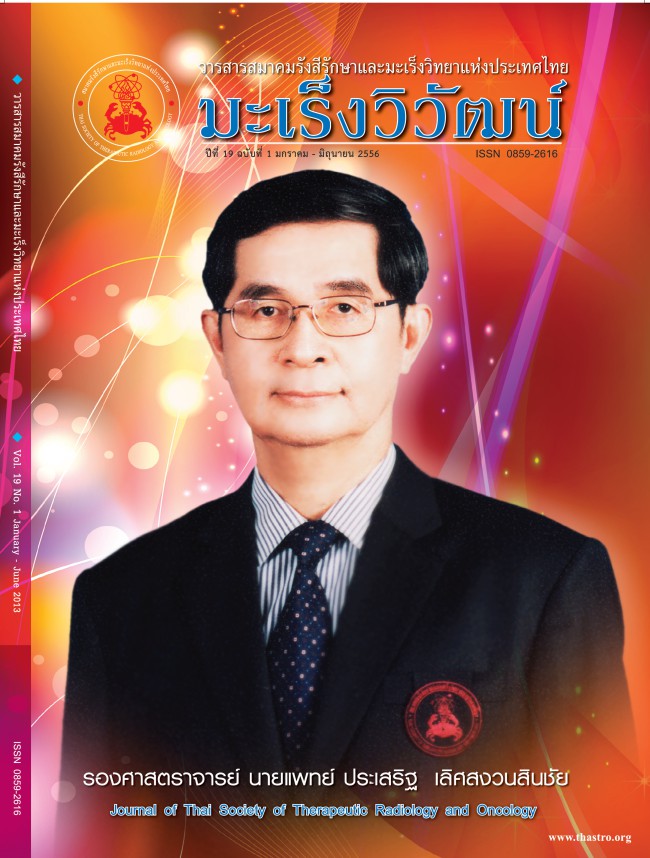DOSIMETRIC COMPARISON AT CRIBRIFORM PLATE AND MIDDLE CRANIAL FOSSA BETWEEN DIFFERENT ISOCENTERS IN WHOLE SUBARACHNOID IRRADIATION
Keywords:
Dosimetric comparison, whole subarachnoid irradiation, cribriform plate, middle cranial fossaAbstract
Backgrounds : For whole subarachnoid irradiation in patients with CSF seeding tumor, an important factor of tumor recurrence and survival rate is adequate tumor coverage. The two common missing area are cribriform plate and middle cranial fossa. Objectives : To compare dose coverage at cribriform plate and middle cranial fossa from prophylactic cranial irradiation between using lateral orbital rim isocenter and mid-brain point isocenter technique. Materials and Methods : The study was performed in patients having undergone cranial CT simulation from January 2011 to February 2012. Two-lateral-opposed whole subarachnoid irradiation was planned on CT brain images using two different points of isocenters, i.e. at mid-brain point (point A) for plan A and at lateral orbital rim (point B) for plan B. The Varian Eclipse planning system version 8.0 was applied. Isodose distributions were assessed at cribriform plate, middle cranial fossa and eye lenses for each plan. Results : All 44 patients were enrolled in this study. The median age of patients was 38 years. Male patients were 26 (59.1% ) and female patients were 18 (40.9% ). The most common diagnosis was CNS tumor (63.64 %). The study found that plan B significantly improved the minimum doses at CTV and PTV (p-value = 0.001 and 0.002, respectively). Mean lens dose in plan B was more than in plan A by 3.6 percentage points of the prescribed dose. Conclusions : Using isocenter at lateral orbital rim for prophylactic cranial irradiation increased the dose coverage of the minimum dose at whole brain, especially in the area of cribriform plate and middle cranial fossa comparing with using mid-brain point isocenter technique.
References
Gripp S, Doeker R, Glag M, Vogelsang P, Bannach B, Doll T,et al. The role of CT simulation in whole-brain irradiation. Int J Radiat Oncol Biol Phys 1999;45:1081–8.
Andic F, Ors Y, Niang U, Kuzhan A, Dirier A. Dosimetric comparison of conventional helmet - field whole- brain irradiation with three- dimensional conformal radiotherapy : dose homogeneity and retro-orbital area coverage. Br J of radiology 2009;82:118-22.
Kortmann RD, Hess CF, Hoffmann W, Jany R, Bamberg M. Is the standardized helmet technique adequate for irradiation of the brain and the cranial meninges? Int J Radiat Oncol Biol Phys 1995;32:241-4.
Weiss E, Krebeck M, Ko¨hler B, Pradier O, Hess CF. Does the standardized helmet technique lead to adequate coverage of the cribriform plate? An analysis of current practice with respect to the ICRU 50 report. Int J Radiat Oncol Biol Phys 2001;49:1475-80.
Grabenbauer GG, Beck JD, Erhardt J, Seegenschmiedt MH, Seyer H, Thierauf P, et al. Postoperative radiatiotherapy of medulloblastoma. Am J Clin Oncol 1996;19:73-7.
Miralbell R, Bleher A, Huguenin P, Ries G, Kann R, Mirimanoff RO, et al. Pediatric medulloblastoma:Radiation treatment technique and patterns of failure. Int J Radiat Oncol Biol Phys 1997;37:523–9.
Carrie C, Alapetite C, Mere P, Aimard L, Pons A, Kolodie H, et al .Quality control of radiotherapeutic treatment of medulloblastoma in a multicentric study: The contribution of radiotherapy technique to tumour relapse. Radiother Oncol 1992; 24:77– 81.
Downloads
Published
How to Cite
Issue
Section
License
บทความที่ได้รับการตีพิมพ์เป็นลิขสิทธิ์ของวารสารมะเร็งวิวัฒน์ ข้อความที่ปรากฏในบทความแต่ละเรื่องในวารสารวิชาการเล่มนี้เป็นความคิดเห็นส่วนตัวของผู้เขียนแต่ละท่านไม่เกี่ยวข้องกับ และบุคคลากรท่านอื่น ๆ ใน สมาคมฯ แต่อย่างใด ความรับผิดชอบองค์ประกอบทั้งหมดของบทความแต่ละเรื่องเป็นของผู้เขียนแต่ละท่าน หากมีความผิดพลาดใดๆ ผู้เขียนแต่ละท่านจะรับผิดชอบบทความของตนเองแต่ผู้เดียว




